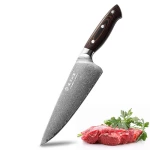The Ins and Outs of Knife Handles: What to Look for in a Comfortable and Secure Grip

Choosing the right knife handle is crucial for achieving a comfortable and secure grip, as it directly impacts your control, maneuverability, and overall safety. Here's a comprehensive guide on what to look for in a knife handle:
1.Material:
Wood: Wood handles are popular for their aesthetic appeal and comfort. However, they may require more maintenance to prevent warping or cracking.
Plastic/Polymer: Lightweight and durable, these handles are often resistant to moisture and provide a good grip. Some advanced polymers offer excellent strength and stability.
Rubber: Offers a non-slip grip, even when wet. Rubber handles are comfortable and shock-absorbent, making them suitable for heavy-duty tasks.
Metal: Commonly found in professional kitchen knives, metal handles are durable and hygienic. They are often textured or have added grips to improve handling.
2.Texture and Ergonomics:
Grip Texture: Look for a handle with a textured surface to prevent slipping, especially when handling wet or greasy items.
Ergonomic Design: The handle should be shaped to fit comfortably in your hand, promoting a natural grip. Ergonomic handles reduce hand fatigue during prolonged use.
3.Size and Shape:
Fit to Hand Size: A knife handle should match the size of your hand. It should allow all fingers to comfortably grip the handle without being too small or too large.
Handle Shape: Consider handles with a finger guard or choil, a slight depression where the blade meets the handle, to prevent your hand from slipping onto the blade during use.
4.Balance:
Blade-Handle Ratio: A well-balanced knife has an even distribution of weight between the blade and handle. This balance enhances control and reduces strain during use.
Center of Gravity: The center of gravity should be around the bolster or where the blade meets the handle. This ensures stability and control while cutting.
5.Bolster and Guard:
Bolster: The bolster is a thick band of metal between the blade and handle. It adds weight for balance and provides a safe transition between the blade and handle.
Guard: Some knives have a guard that prevents your hand from slipping onto the blade. It's particularly important for larger knives used in heavy-duty tasks.
6.Tang:
Full Tang: A full tang extends the entire length of the handle, providing strength and stability. Knives with full tangs are generally more robust and durable.
Partial Tang: Some knives have a partial tang, where the metal extends partway into the handle. While lighter, they may not be as sturdy as full tang knives.
7.Maintenance:
Hygiene: Consider the ease of cleaning and maintaining the handle. Materials like plastic, rubber, and stainless steel are often more resistant to moisture and can be easily cleaned.
8.Personal Preference:
Try Before Buying: Whenever possible, hold the knife to assess how it feels in your hand. Personal preference plays a significant role in choosing a comfortable grip.
By considering these factors, you can find a knife with a handle that not only fits your hand comfortably but also provides a secure grip for efficient and safe use.







